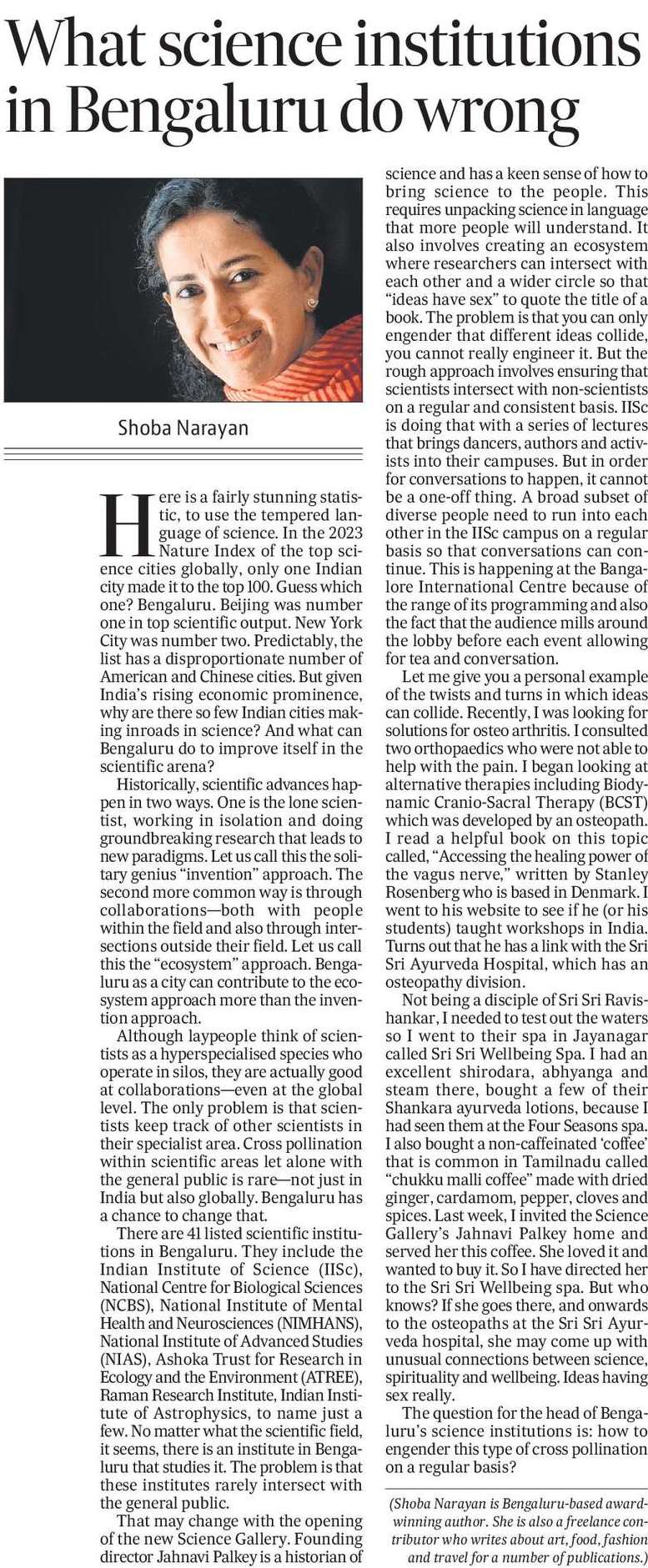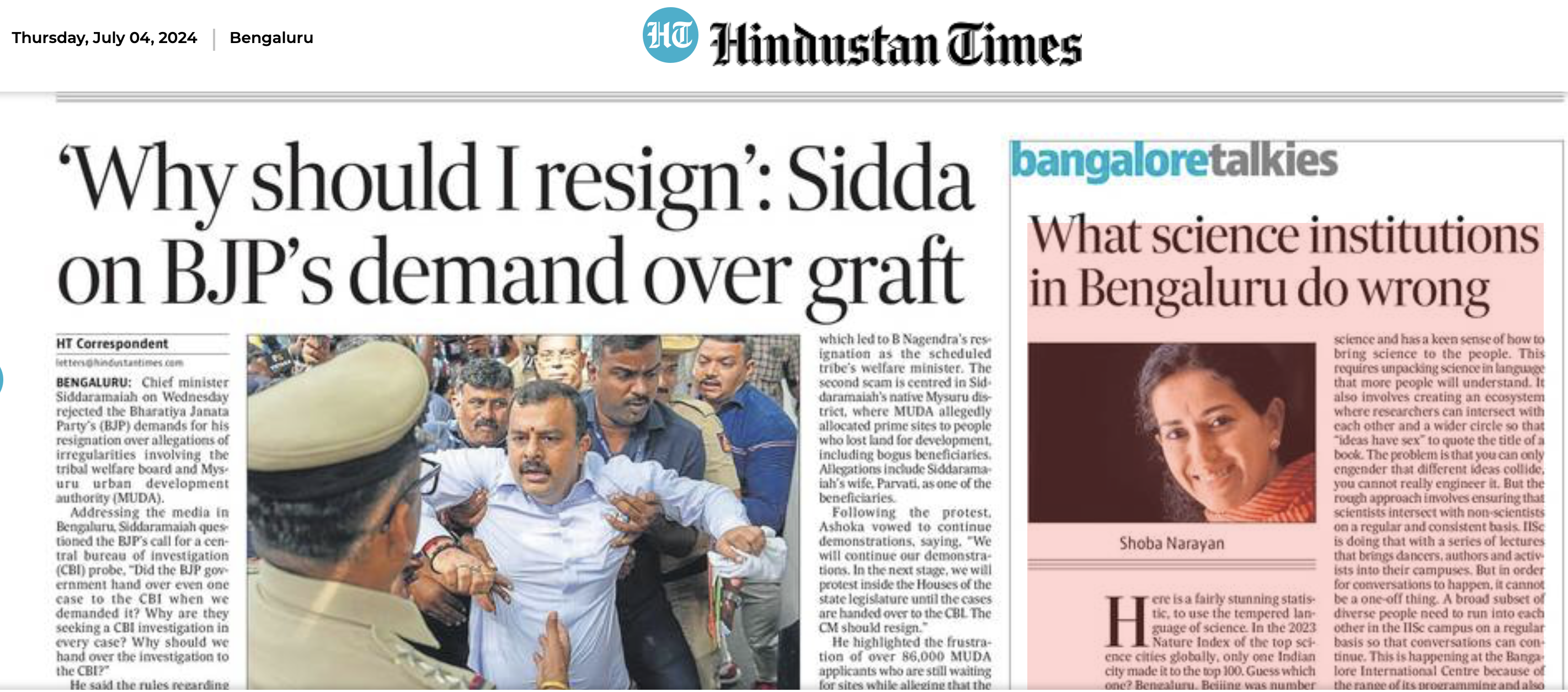Here is a fairly stunning statistic, to use the tempered language of science. In the 2023 Nature Index of the top science cities globally, only one Indian city made it to the top 100. Guess which one? Bengaluru. Beijing was number one in top scientific output. New York City was number two. Predictably, the list has a disproportionate number of American and Chinese cities. But given India’s rising economic prominence, why are there so few Indian cities making inroads in science? And what can Bengaluru do to improve itself in the scientific arena?
Historically, scientific advances happen in two ways. One is the lone scientist, working in isolation and doing groundbreaking research that leads to new paradigms. Let us call this the solitary genius “invention” approach. The second more common way is through collaborations—both with people within the field and also through intersections outside their field. Let us call this the “ecosystem” approach. Bengaluru as a city can contribute to the ecosystem approach more than the invention approach.
Although laypeople think of scientists as a hyperspecialized species who operate in silos, they are actually good at collaborations—even at the global level. The only problem is that scientists keep track of other scientists in their specialist area. Cross pollination within scientific areas let alone with the general public is rare—not just in India but also globally. Bangalore has a chance to change that.
There are 41 listed scientific institutions in Bangalore. They include the Indian Institute of Science (IISc), National Centre for Biological Sciences (NCBS), National Institute of Mental Health and Neurosciences (NIMHANS), National Institute of Advanced Studies (NIAS), Ashoka Trust for Research in Ecology and the Environment (ATREE), Raman Research Institute, Indian Institute of Astrophysics, to name just a few. No matter what the scientific field, it seems, there is an institute in Bangalore that studies it. The problem is that these institutes rarely intersect with the general public.
That may change with the opening of the new Science Gallery. Founding director Jahnavi Palkey is a historian of science and has a keen sense of how to bring science to the people. This requires unpacking science in language that more people will understand. It also involves creating an ecosystem where researchers can intersect with each other and a wider circle so that “ideas have sex” to quote the title of a book. The problem is that you can only engender that different ideas collide, you cannot really engineer it. But the rough approach involves ensuring that scientists intersect with non-scientists on a regular and consistent basis. IISc is doing that with a series of lectures that brings dancers, authors and activists into their campuses. But in order for conversations to happen, it cannot be a one-off thing. A broad subset of diverse people need to run into each other in the IISc campus on a regular basis so that conversations can continue. This is happening at the Bangalore International Centre because of the range of its programming and also the fact that the audience mills around the lobby before each event allowing for tea and conversation.
Let me give you a personal example of the twists and turns in which ideas can collide. Recently, I was looking for solutions for osteo arthritis. I consulted two orthopaedics who were not able to help with the pain. I began looking at alternative therapies including Biodynamic Cranio-Sacral Therapy (BCST) which was developed by an osteopath. I read a helpful book on this topic called, “Accessing the healing power of the vagus nerve,” written by Stanley Rosenberg who is based in Denmark. I went to his website to see if he (or his students) taught workshops in India. Turns out that he has a link with the Sri Sri Ayurveda Hospital, which has an osteopathy division. Not being a disciple of Sri Sri Ravishankar, I needed to test out the waters so I went to their spa in Jayanagar called Sri Sri Wellbeing Spa. I had an excellent shirodara, abhyanga and steam there, bought a few of their Shankara ayurveda lotions, because I had seen them at the Four Seasons spa. I also bought a non-caffeinated ‘coffee’ that is common in Tamilnadu called “chukku malli coffee” made with dried ginger, cardamom, pepper, cloves and spices. Last week, I invited the Science Gallery’s Jahnavi Palkey home and served her this coffee. She loved it and wanted to buy it. So I have directed her to the Sri Sri Wellbeing spa. But who knows? If she goes there, and onwards to the osteopaths at the Sri Sri Ayurveda hospital, she may come up with unusual connections between science, spirituality and wellbeing. Ideas having sex really.
The question for the head of Bangalore’s science institutions is: how to engender this type of cross pollination on a regular basis?
Shoba Narayan is Bangalore-based award-winning author. She is also a freelance contributor who writes about art, food, fashion and travel for a number of publications.



-k4lD-U204025897261YmH-250x250%40HT-Web.jpg)




Interesting reading! Very important observations!